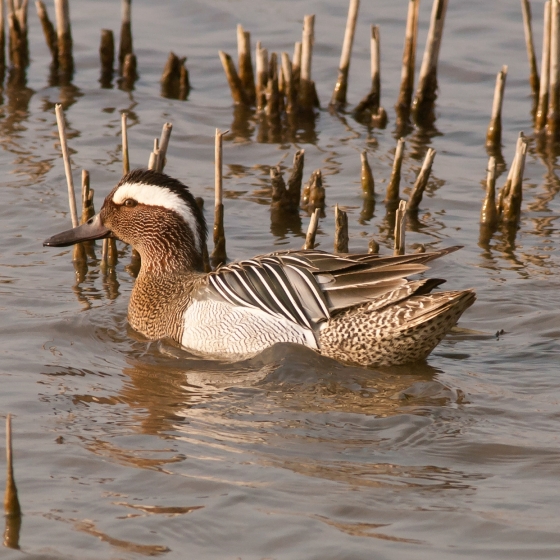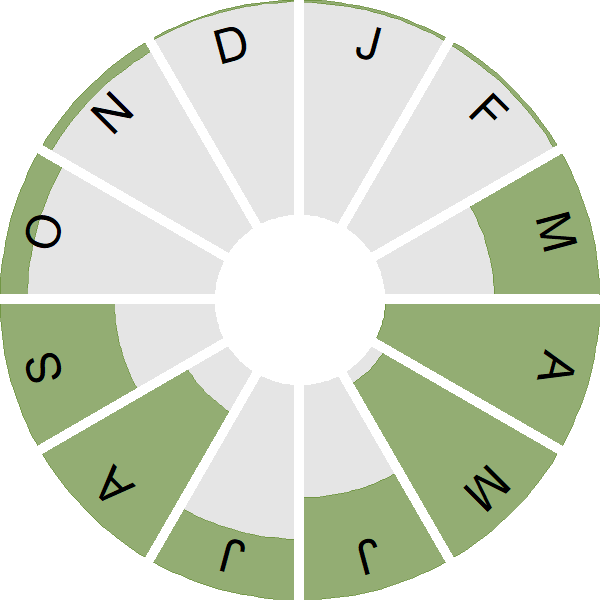Garganey

Introduction
Unlike most of Britain's ducks the Garganey is a summer visitor, arriving in early spring from its wintering grounds in Africa.
BirdTrack records show that the species is widely recorded in spring on lakes, marshes and wet meadows, but assessing the size of the breeding population is difficult owing to the birds' secretive nature. An estimate of around 100 pairs makes this a rare duck, although the British population is important in a European context.
Male Garganey are striking, with their rich brown head and neck, long prominent curving white eyebrow and black and white plumes above neat grey flanks.

Key Stats
Identification
ID Videos
This section features BTO training videos headlining this species, or featuring it as a potential confusion species.
Garganey & Teal
Songs and Calls
Call:
Status and Trends
Conservation Status
Population Change
The Garganey is difficult to monitor as breeding occurs at extensive wetland sites where it is difficult to confirm, and the presence of pairs in suitable habitat may also relate to passage birds. RBBP data suggest that numbers have recently increased to a five-year mean of 120 pairs for the period 2015–2019, with numbers stable over the last 25 years but remaining slightly below the peak of 163 pairs in 1993 (Eaton et al. 2021).
Distribution
Widely recorded in spring on lakes, marshlands and wet meadows, the Garganey is surely among the most difficult duck to census as a breeding bird. The breeding distribution map shows that records with breeding evidence were received from 199 10-km squares in Britain and 13 in Ireland. Favoured areas are around the Ouse Washes and nearby fenland sites, Norfolk Broads, Somerset Levels, northeast and northwest England coastlines.
Occupied 10-km squares in UK
or view it on Bird Atlas Mapstore.
or view it on Bird Atlas Mapstore.
European Distribution Map
Distribution Change
Change in occupied 10-km squares in the UK
or view it on Bird Atlas Mapstore.
or view it on Bird Atlas Mapstore.
Seasonality
Garganey are localised summer visitor with a pronounced pattern of detection in spring and autumn bookending low detection during the breeding season; occasional birds winter.
Weekly pattern of occurrence
The graph shows when the species is present in the UK, with taller bars indicating a higher likelihood of encountering the species in appropriate regions and habitats.

Movement
Britain & Ireland movement
Foreign locations of birds ringed or recovered in Britain & Ireland
Dots show the foreign destinations of birds ringed in Britain & Ireland, and the origins of birds ringed overseas that were subsequently recaptured, resighted or found dead in Britain & Ireland. Dot colours indicate the time of year that the species was present at the location.
- Winter (Nov-Feb)
- Spring (Mar-Apr)
- Summer (May-Jul)
- Autumn (Aug-Oct)

European movements
EuroBirdPortal uses birdwatcher's records, such as those logged in BirdTrack to map the flows of birds as they arrive and depart Europe. See maps for this species here.
The Eurasian-African Migration Atlas shows movements of individual birds ringed or recovered in Europe. See maps for this species here.
Biology
Productivity and Nesting
Nesting timing
Egg measurements
Clutch Size
Survival and Longevity
Survival is shown as the proportion of birds surviving from one year to the next and is derived from bird ringing data. It can also be used to estimate how long birds typically live.
View number ringed each year in the Online Ringing Report.
lifespan
Survival of adults
Survival of juveniles
Biometrics
Wing length and body weights are from live birds (source).
Ring Size
Classification, names and codes
Classification and Codes
- Order: Anseriformes
- Family: Anatidae
- Scientific name: Spatula querquedula
- Authority: Linnaeus, 1758
- BTO 2-letter code: GY
- BTO 5-letter code: GARGA
- Euring code number: 1910
Alternate species names
- Catalan: xarrasclet
- Czech: círka modrá
- Danish: Atlingand
- Dutch: Zomertaling
- Estonian: rägapart
- Finnish: heinätavi
- French: Sarcelle d’été
- Gaelic: Lach-crann
- German: Knäkente
- Hungarian: böjti réce
- Icelandic: Taumönd
- Irish: Praslacha Shamhraidh
- Italian: Marzaiola
- Latvian: prikške
- Lithuanian: dryžagalve krykle
- Norwegian: Knekkand
- Polish: cyranka (zwyczajna)
- Portuguese: marreco
- Slovak: kacica chrapacka
- Slovenian: reglja
- Spanish: Cerceta carretona
- Swedish: årta
- Welsh: Hwyaden Addfain
- English folkname(s): Summer/Cricket Teal
Research
Causes of Change and Solutions
Causes of change
It is unclear why Garganey numbers appear relatively stable in the UK. Conservation management and creation of new wetlands in order to support species including the Bittern may have helped ensure that the condition and availability of habitat for Garganey has remained favourable in the UK.

